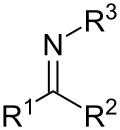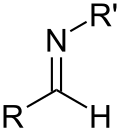-
Copper(II) complex of the Schiff base ligand salicylaldoxime.
-
Salen is a common tetradentate ligand that becomes deprotonated upon complexation.
-
Jacobsen's catalyst is derived from a chiral salen ligand.
-
Generic diiminopyridine complex
Schiff base
 From Wikipedia - Reading time: 6 min
From Wikipedia - Reading time: 6 min


In organic chemistry, a Schiff base (named after Hugo Schiff) is a compound with the general structure R1R2C=NR3 (R3 = alkyl or aryl, but not hydrogen).[1][2] They can be considered a sub-class of imines, being either secondary ketimines or secondary aldimines depending on their structure. Anil refers to a common subset of Schiff bases: imines derived from anilines.[3] The term can be synonymous with azomethine which refers specifically to secondary aldimines (i.e. R−CH=NR' where R' ≠ H).[4]
Synthesis
[edit]Schiff bases can be synthesized from an aliphatic or aromatic amine and a carbonyl compound by nucleophilic addition forming a hemiaminal, followed by a dehydration to generate an imine. In a typical reaction, 4,4'-oxydianiline reacts with o-vanillin:[5]

Schiff bases can also be synthesized via the Aza-Wittig reaction.
Biochemistry
[edit]Schiff bases have been investigated in relation to a wide range of contexts, including antimicrobial, antiviral and anticancer activity. They have also been considered for the inhibition of amyloid-β aggregation.[6]
Schiff bases are common enzymatic intermediates where an amine, such as the terminal group of a lysine residue, reversibly reacts with an aldehyde or ketone of a cofactor or substrate. The common enzyme cofactor pyridoxal phosphate (PLP) forms a Schiff base with a lysine residue and is transaldiminated to the substrate(s).[7] Similarly, the cofactor retinal forms a Schiff base in rhodopsins, including human rhodopsin (via Lysine 296), which is key in the photoreception mechanism.
Coordination chemistry
[edit]The term Schiff base is normally applied to these compounds when they are being used as ligands to form coordination complexes with metal ions.[8] One example is Jacobsen's catalyst. The imine nitrogen is basic and exhibits pi-acceptor properties. Several, especially the diiminopyridines are noninnocent ligands. Many Schiff base ligands are derived from alkyl diamines and aromatic aldehydes.[9]
Chiral Schiff bases were one of the first ligands used for asymmetric catalysis. In 1968 Ryōji Noyori developed a copper-Schiff base complex for the metal-carbenoid cyclopropanation of styrene.[10] Schiff bases have also been incorporated into metal–organic frameworks (MOF).[11]

Conjugated Schiff bases
[edit]Conjugated Schiff bases absorb strongly in the UV-visible region of the electromagnetic spectrum. This absorption is the basis of the anisidine value, which is a measure of oxidative spoilage for fats and oils.
Historic references
[edit]- Schiff, Hugo (1864). "Mittheilungen aus dem Universitäts-laboratorium in Pisa: 2. Eine neue Reihe organischer Basen" [Communications from the university laboratory in Pisa: 2. A new series of organic bases]. Annalen der Chemie und Pharmacie (in German). 131: 118–119. doi:10.1002/jlac.18641310113.
- Schiff, Hugo (1866). "Sopra una nova serie di basi organiche" [On a new series of organic bases]. Giornale di Scienze Naturali ed Economiche (in Italian). 2: 201–257.
- Schiff, Hugo (1866). "Eine neue Reihe organischer Diamine" [A new series of organic diamines]. Annalen der Chemie und Pharmacie, Supplementband (in German). 3: 343–370.
- Schiff, Hugo (1866). "Eine neue Reihe organischer Diamine. Zweite Abtheilung" [A new series of organic diamines. Second part.]. Annalen der Chemie und Pharmacie (in German). 140: 92–137. doi:10.1002/jlac.18661400106.
References
[edit]- ^ IUPAC, Compendium of Chemical Terminology, 5th ed. (the "Gold Book") (2025). Online version: (2006–) "Schiff base". doi:10.1351/goldbook.S05498
- ^ Smith, Michael B.; March, Jerry (2007), Advanced Organic Chemistry: Reactions, Mechanisms, and Structure (6th ed.), New York: Wiley-Interscience, p. 1281, ISBN 978-0-471-72091-1
- ^ IUPAC, Compendium of Chemical Terminology, 5th ed. (the "Gold Book") (2025). Online version: (2006–) "anil". doi:10.1351/goldbook.A00357
- ^ IUPAC, Compendium of Chemical Terminology, 5th ed. (the "Gold Book") (2025). Online version: (2006–) "azomethines". doi:10.1351/goldbook.A00564
- ^ Jarrahpour, A. A.; M. Zarei (February 24, 2004). "Synthesis of 2-({[4-(4-{[(E)-1-(2-hydroxy-3-methoxyphenyl)methylidene amino}phenoxy)phenyl imino}methyl)- 6 -methoxy phenol". Molbank. M352. ISSN 1422-8599. Retrieved February 22, 2010.
- ^ Bajema, Elizabeth A.; Roberts, Kaleigh F.; Meade, Thomas J. (2019). "Chapter 11. Cobalt-Schiff Base Complexes:Preclinical Research and Potential Therapeutic Uses". In Sigel, Astrid; Freisinger, Eva; Sigel, Roland K. O.; Carver, Peggy L. (eds.). Essential Metals in Medicine:Therapeutic Use and Toxicity of Metal Ions in the Clinic. Metal Ions in Life Sciences. Vol. 19. Berlin: de Gruyter GmbH. pp. 267–301. doi:10.1515/9783110527872-017. ISBN 978-3-11-052691-2. PMID 30855112. S2CID 73727460.
- ^ Eliot, A. C.; Kirsch, J. F. (2004). "PYRIDOXALPHOSPHATEENZYMES: Mechanistic, Structural, and Evolutionary Considerations". Annual Review of Biochemistry. 73: 383–415. doi:10.1146/annurev.biochem.73.011303.074021. PMID 15189147. S2CID 36010634.
- ^ Kaczmarek, Malgorzata T.; Zabiszak, Michal; Nowak, Martyna; Jastrzab, Renata (2018). "Lanthanides: Schiff base complexes, applications in cancer diagnosis, therapy, and antibacterial activity". Coordination Chemistry Reviews. 370: 42–54. doi:10.1016/j.ccr.2018.05.012.
- ^ Hernández-Molina, R.; Mederos, A. (2003). "Acyclic and Macrocyclic Schiff Base Ligands". Comprehensive Coordination Chemistry II. pp. 411–446. doi:10.1016/B0-08-043748-6/01070-7. ISBN 9780080437484.
- ^ Nozaki, H.; Takaya, H.; Moriuti, S.; Noyori, R. (1968). "Homogeneous catalysis in the decomposition of diazo compounds by copper chelates: Asymmetric carbenoid reactions". Tetrahedron. 24 (9): 3655–3669. doi:10.1016/S0040-4020(01)91998-2.
- ^ Uribe-Romo, Fernando J.; Hunt, Joseph R.; Furukawa, Hiroyasu; KlöCk, Cornelius; o'Keeffe, Michael; Yaghi, Omar M. (2009). "A Crystalline Imine-Linked 3-D Porous Covalent Organic Framework". J. Am. Chem. Soc. 131 (13): 4570–4571. doi:10.1021/ja8096256. PMID 19281246.
 KSF
KSF


